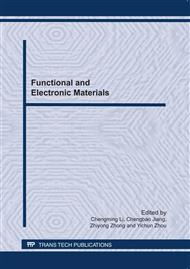p.309
p.315
p.321
p.327
p.333
p.339
p.343
p.348
p.354
Molten Salt Synthesis of Anisotropy BaBi4Ti4O15 Powders in K2SO4-Na2SO4 Flux
Abstract:
Anisotropic BaBi4Ti4O15 powder was synthesized by a molten salt synthesis (MSS) method in K2SO4-Na2SO4 flux and the effects of different process parameters such as calcining temperature, and ratio of salt to reactant (R) on the phase formation and morphology of anisotropic BaBi4Ti4O15 particles were also investigated. The as-synthesized powder calcined at 850-950°C exhibits a single tetragonal BaBi4Ti4O15 phase. The morphology of BaBi4Ti4O15 powder could be adjusted by changing the synthesis conditions. The average particle size (APS) of BaBi4Ti4O15 powder increased with R changing from 0.8 to 1.0, while it decreased with further increasing of R to 1.2. In addition, the APS increased with increasing calcining temperature and it showed an Arrhenius dependence on the temperature. The corresponding apparent activation energy for particle growth is 31.9kJ/mol for calcining temperature of 850-1000°C.
Info:
Periodical:
Pages:
333-338
Citation:
Online since:
June 2011
Authors:
Keywords:
Price:
Сopyright:
© 2011 Trans Tech Publications Ltd. All Rights Reserved
Share:
Citation:


